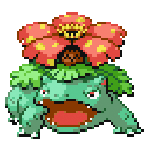Venusaur
フシギバナ
The English name, at first glance, is nothing more than a combination of venus and saur but it might be hiding something underneath all those leaves.
We've already covered in previous posts how the suffix saur means lizard and originates from the Greek word saûros.
The venus in Venusaur's name is mostly referring to a plant known as the Venus Flytrap. Later Pokedex entries describe how the flower releases a soothing scent that attracts Pokémon and calms emotions. This scent becomes stronger after a rainy day. Venus Flytraps in fact attract prey through the scent of the nectar they secrete. Adding further evidence to the Venus Flytrap connection is the similarity in colour between the inside of the Venus Flytrap and that of the Venusaur petals.
Something to think about is the possible reference to the goddess Venus. Most of us might know Venus as the goddess of love in Roman mythology but there is a more ancient Italian deity believed at the time to be a goddess of gardens and spring. The International Phonetic Alphabet describes Venus as /ˈviːnəs/ which you might notice looks like vines. Ivy, as described under Ivysaur, is a type of vine. I have no idea if this was intentional but it's definitely a happy coincidence if not.
The Japanese is a simpler combination of words in comparison to the English.
The Katakana フシギバナ can be rewritten in Hiragana as ふしぎばな. In the Bulbasaur and Ivysaur entries we already covered how ふしぎ (fushigi) translates to strange, wonderful, amazing, curious, and mysterious. In Hiragana, flower is written as はな (hana) and is a perfect fit for Venusaur given how the bulb is now fully blossomed in the final form.
But you'll notice that the second part of Venusaur's name is not written as はな (hana) but instead is ばな (bana). Flower is usually written in Hiragana as はな so what is with the modified は? My limited knowledge led me to the word 生け花 (いけばな in kana or ikebana in romaji) which means "Japanese art of flower arrangement". The Kanji 花 in this word is the character for flower. It is usually pronounced "hana" on its own but seems to be pronounced bana when at the end of 生け花 (ikebana).
I suspect the use of ばな (bana) is to not make the Japanese name for Venusaur too literal and at the same time reference the art of flower arrangement now that Bulbasaur has evolved and the flower is fully arranged. After all, the Generation 1 description for Venusaur is The plant blooms when it is absorbing solar energy.
In closing, Venusaur now emphasises how Bulbasuar ("Strange seed, isn't it?") has now evolved into a "Strange flower".